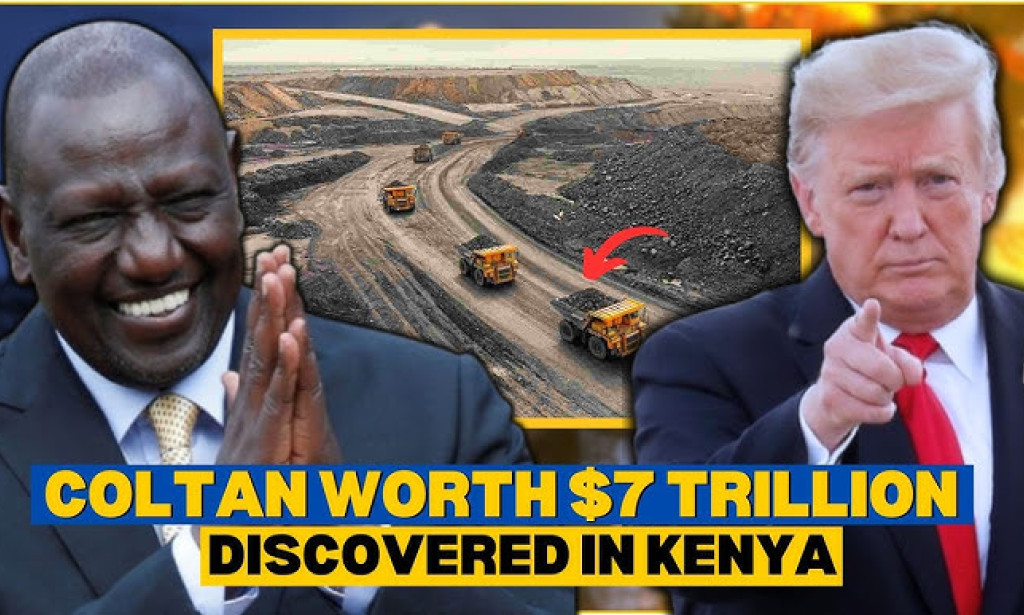A massive mineral find beneath Kenya's soil has put the country on the global mining map—but history suggests this "blessing" could become Africa's latest resource curse.
Deep beneath the rolling hills of Kenya lies a discovery that could reshape the nation's destiny. In early 2024, Mining Minister Salim Mvurya confirmed what geological surveys had long suggested: Kenya sits atop significant deposits of coltan, the dull black metallic ore that powers our digital age.
For those unfamiliar with this critical mineral, coltan—short for columbite-tantalite—is the source of tantalum, a miracle metal essential to modern electronics. The smartphone in your pocket, the laptop on your desk, the data centers running the internet—all depend on tantalum's unique ability to store and release electrical charges in tiny, high-performance capacitors.
The economic promise appears staggering. Kenya's mining sector currently contributes less than 1% of national GDP, but projections suggest a major coltan operation could surge this figure to 10%. With global coltan prices fluctuating between $48-$70 per kilogram, the numbers quickly become dizzying.
Yet for many Kenyans, government optimism is met with hard-earned skepticism. They've heard these grand promises before.
The Ghost of Promises Past
This isn't Kenya's first resource rodeo. The oil discovery in Turkana County began with similar fanfare—headlines screaming of transformation for one of the country's most marginalized regions. What followed was a slow, agonizing fizzle of contractual disputes, logistical nightmares, and the stark realization that promised wealth wasn't trickling down to local communities.
The pattern has bred deep wariness. Upon hearing of the coltan discovery, Embu County MP Njibari Muriuki immediately urged residents not to sell their land—a direct acknowledgment of the coming storm of speculators and powerful interests who see ancestral homes as commodities to be bought cheaply and exploited ruthlessly.
This phenomenon has a name: the resource curse. It's a bitter paradox plaguing Africa for over a century, where countries blessed with immense natural wealth often suffer from slower economic growth, more conflict, and deeper corruption than resource-poor nations.
Blueprint for Destruction: Lessons from Congo
To understand the stakes, Kenya needs only look east to the Democratic Republic of Congo, which produces roughly 40% of the world's coltan. For the past quarter-century, this incredible wealth hasn't brought prosperity—it has unleashed hell on earth.
The DRC's coltan has fueled sprawling wars and rebellions linked to millions of deaths. The story follows a chilling pattern: rival militias, often backed by foreign interests, wage war for control of mining territories. They're not fighting for ideology—they're fighting for minerals. Control the coltan mine, control the funding for more weapons and territorial expansion.
At the bottom of this pyramid are the artisanal miners—ordinary Congolese people, including tragically many children, who risk their lives daily for pittance wages. They work in horrific conditions, digging unstable tunnels with basic tools. Tunnel collapses are frequent and fatal. For a full day of backbreaking, dangerous labor, a miner might earn just a few dollars.
The coltan they extract is sold to local traders and smuggled across borders, often into Rwanda, where its bloody origin is deliberately obscured. By the time the mineral reaches electronics giants, its connection to child labor and conflict has been conveniently laundered away.
Meanwhile, the DRC—sitting atop one of the world's most valuable mineral deposits—remains among the planet's poorest countries, its people left with polluted rivers and a legacy of violence.
This is the blueprint. This is the model of extraction perfected over decades. And this is the danger now standing at Kenya's doorstep.
Environmental Apocalypse
Beyond human tragedy lies another devastation: environmental destruction. Much of the world's coltan comes from chaotic, unregulated artisanal mining. To reach the ore, miners clear vast swaths of land. Centuries-old forests are bulldozed, rich topsoil scraped away, leaving behind scarred, barren moonscapes.
For Kenya—renowned for its biodiversity—the threat is existential. These forests are vital ecosystems and water towers, regulating rivers that provide water for millions. Mining devastation leads directly to habitat loss, pushing wildlife toward extinction while unleashing toxic pollution.
The mining process creates acid mine drainage when exposed rock mixes with air and water, leaching heavy metals into streams and rivers, killing aquatic life, and poisoning water sources. The constant dust clouds contain toxic elements, causing severe respiratory diseases among miners and nearby residents.
The profits are privatized while the costs—poisoned water, barren land, sick children—become the permanent burden of host nations.
The New Scramble for Africa
Kenya's coltan announcement rang like a dinner bell for the global mining industry. Three main groups of players are now converging on the country:
Western Powers see Kenya's coltan through a geopolitical lens. The US and EU have awakened to a terrifying reality: China dominates global supply chains for critical minerals needed for green energy and high-tech manufacturing. The dependency is viewed as a major security risk, triggering initiatives like the US-led Mineral Security Partnership—a coalition of Western allies aimed at securing mineral supply chains while pointedly excluding China.
China has been the most aggressive foreign actor in Africa's resource sectors for two decades. While the West debated, China built roads and ports in exchange for mineral access. The China-Kenya relationship strengthened significantly in 2025 with numerous bilateral agreements covering infrastructure, energy, and technology. Though coltan was never explicitly mentioned, these agreements create frameworks for future mining deals.
However, Chinese mining operations in Africa face accusations of worker exploitation and regulatory violations. In January 2024, Kenya suspended two Chinese mining companies for non-compliance—a stark reminder that investment doesn't always equal responsible partnership.
Multinational Mining Corporations from Canada, Australia, and the UK are constantly hunting for the next big find. Companies like London-listed Marula Mining are already active in Kenya, explicitly targeting battery metals often found alongside coltan. Their executives speak openly of a "strategic rush" from global economies to get involved.
Officials in Embu County report foreign investors are already "thirsty to venture into the mining business." The stage is set for a bidding war where the prize is often the resource itself, with local population welfare becoming collateral damage.
A Different Path Forward
The future isn't written. Kenya's coltan story doesn't have to end in tragedy. Avoiding the curse isn't luck—it is a choice requiring five critical steps:
1. Radical Transparency
The secretive backroom deals defining African resource extraction enable corruption. Every contract, license, and payment from mining companies to the government must be public. Kenyans have the right to know who's mining their resources, the terms involved, and where every shilling goes.
2. Ironclad Law Enforcement
Kenya has environmental and labor laws, but they're meaningless without enforcement. The government must fund environmental agencies to conduct rigorous, independent impact assessments before any mining begins. These cannot be rubber-stamped exercises paid for by mining companies. Labor laws must ensure fair wages, safe working conditions, and a complete ban on child labor.
3. Value Addition Revolution
The colonial model extracts raw materials from Africa for processing elsewhere, where real money is made. A kilogram of raw coltan is valuable, but derived tantalum powder is far more so. Kenya must break this cycle by demanding, as a licensing condition, that companies invest in processing and refining facilities inside Kenya. Building smelters would create higher-skilled jobs, transfer technology, and capture a much larger share of the resource's final value.
4. Direct Community Benefit
Wealth from the ground must be felt by people living on that ground. While laws suggesting 20% of proceeds go to counties and 10% to local communities are a start, the system must be transparent and robust. Money must flow into tangible, community-prioritized projects, such as schools, health clinics, and clean water systems.
5. Learning from History
The DRC's tragedy isn't secret—it's a well-documented warning. Kenya must study these lessons and build firewalls preventing similar tactics from taking root. The economy must diversify beyond single-commodity dependence, which gives foreign powers immense leverage.
The Fight for Africa's Future
This difficult path requires resisting easy money and maintaining government accountability to people over foreign corporations. But it's the only path leading away from the curse.
Kenya faces a monumental challenge but also a historic opportunity to finally write a new story for Africa—one where mineral wealth leads not to plunder, but to genuine, lasting prosperity.
The forces gathering to exploit this resource are powerful and organized, but not invincible. Their greatest fear is an informed, engaged, and outraged public. Kenya's coltan discovery represents more than a mineral find—it is a test of whether African nations can finally break free from centuries of resource extraction that enriches others while impoverishing host countries.
The question remains: Will Kenya's black gold build a nation or break it? The answer lies not in the ground, but in the choices made above it.
The fight for Africa's treasure has begun. History is watching.


You must be logged in to post a comment.